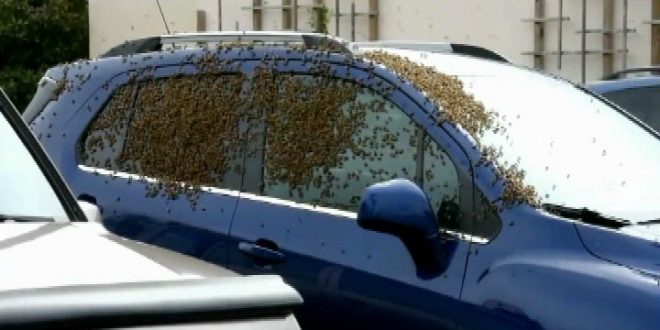There was quite the scene in a South Nanaimo parking lot this morning when a swarm of bees descended an SUV parked outside a Value Village store.
A witness who posted video of the incident on YouTube says it wasn’t clear if the queen bee was inside the vehicle.
The vehicles’s owner Susan Angus told the Nanaimo Daily Bulletin she saw the swarm and said “why me? ”
Mark Schiling, an executive member of the Nanaimo Beekeepers Club said he was dealing with a colony of bees that had taken up residence in a house when he got the call.
“What I heard is the swarm started to settle on two cars side-by-side in the parking lot,” he said. “One of them, the owner just had to go, so she just drove away…There’s a good chance she drove away with the queen,” he said.
“Occasionally a situation such as this comes along and the circumstances are not conducive to relocating the bees easily and effectively,” said Schilling. “I wouldn’t call today’s situation a failure, as I’m sure most of the bees survived, but it wasn’t strictly a success as we weren’t able to re-hive the swarm and look after them to maximize their chances of survival.”
Even though the bees numbered in their thousands and were buzzing excitedly around a large area of the parking lot, they showed no aggression to the beekeepers or passersby and no one suffered any stings.
Preventing Future Invasions
Following extraction of honey bee combs from any site, the odor of beeswax remains. Because honey bees have an extremely acute sense of smell, that odor will be noticeable from a long distance and highly attractive to any future honey bee scouts seeking new nesting sites, long after the previous bees have been removed.
Therefore, after bees have been removed from a building, all holes large enough to insert a pencil, or larger, that lead to spacious cavities in the building must be sealed. Although honey bees can chew out of a building through caulking, they won’t chew in through it. Larger potential entrances can be covered with screen having six or more meshes per inch. Cavities can be filled with expandable foam to make large spaces unsuitable for nesting. The area requiring examination and servicing includes the entire side of the building around the previous entrance or both sides of the building, if the entrance were on a corner. If bees can find access to a void adjacent to the previous nesting site, they’ll move right in.
During the extraction process, some bees are likely to escape. Also, some honey bee foragers spend the night away from the hive in the summer, so there is likely to be a cluster of bees forming around the entrance after the bees and combs have been removed. That small number of bees can be vacuumed up or eliminated with an aerosol spray labeled for use on wasps and bees outside the home.
Agencies/Canadajournal
 Canada Journal – News of the World Articles and videos to bring you the biggest Canadian news stories from across the country every day
Canada Journal – News of the World Articles and videos to bring you the biggest Canadian news stories from across the country every day



